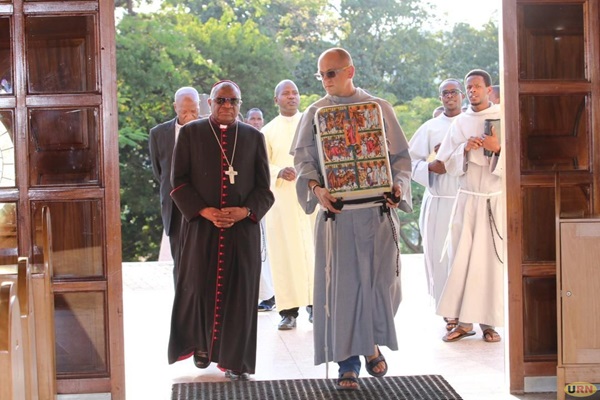
Relics of Uganda Martyrs return as Church marks 60 years of their sainthood
Kampala, Uganda | CHRISTOPHER KISEKKA -URN & INDEPENDENT | The relics of the Uganda Martyrs have been brought back to Uganda for a “special visit” as the nation celebrates 60 years since the canonization of Africa’s first Black saints.
The sacred artefacts, including the bones of Saints Charles Lwanga and Mathias Mulumba, were taken to the Vatican in the 1940s during the Catholic Church’s process of pursuing their canonization. While several of other relics are housed at Namugongo, this particular set has been preserved in Rome ever since the 1940s.
On Monday evening, the relics were delivered by Reverend Father Richard Nyombi, the Coordinator of the Society of Missionaries of Africa in Uganda under the Kampala Archdiocese. They were received at Entebbe Airport by Archbishop Paul Semogerere, who was accompanied by a group of clergy, religious figures, government officials, curators, and representatives from Uganda Martyrs University.
Archbishop Paul Semogerere remarked that Catholics hold a special honour and deeply revere the relics of those who shed their blood for the faith.
He emphasized that both Catholic and non-Catholic Ugandans should take pride in the fact that Uganda stands out as a beacon, attracting hundreds of visitors for religious and tourism reasons. Additionally, he challenged the government to place a prominent sign at the airport to inform visitors that Uganda is, among other things, the land of the famous martyrs.
Upon arrival, the relics, which were contained in a small white suitcase with a photo showing all the martyrs, were displayed before a small group of government officials, clergy and curators and other few individuals who had been granted access.
A few thoughts of my own about the relics of the Uganda Martyrs, which came back to Uganda yesterday afternoon. https://t.co/CTocOQW5UN
— Derek R Peterson (@Unseen_Archive) September 10, 2024
Reverend Father Richard Nyombi opened the suitcase to reveal the relics, which were meticulously covered with a black cloth. Each item inside was wrapped in what appeared to be red clothes or ribbon. Red is the colour the colour of fire, blood and martyrdom in the Catholic church.
As Fr Nyombi picked each one of the relics from the suitcase, he explained its significance to those present who were overjoyed and others clapped in appreciation.
Alongside the bones of the two martyrs, the suitcase contained other notable items.
These included crosses made from the trees where some of the martyrs met their deaths—a cross crafted from a mvule tree at the site where Saint Mathias Mulumba was martyred, and another from a tree where Saint Naoh Mwagali was tied before his execution in Kiyinda-Mityana.
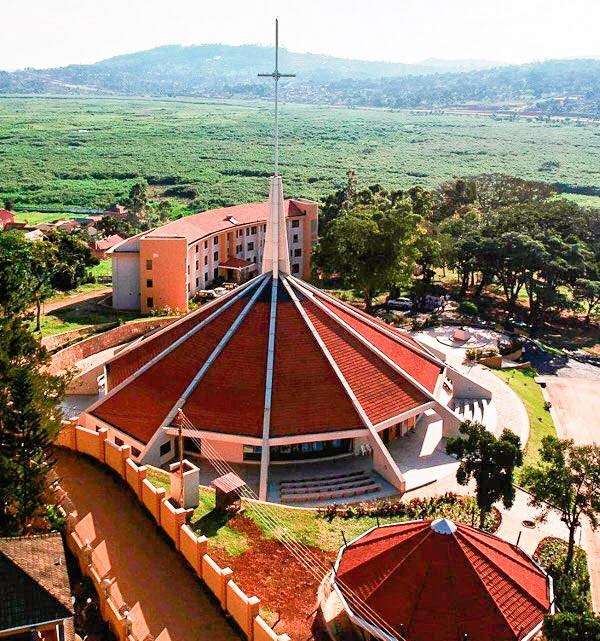
Additionally, the case was held as parts of chains used during the executions of the martyrs and also some documents related to the relics, including DNA evidence gathered during the investigation to confirm their authenticity.
After being received at the airport, the relics were briefly taken to Munyonyo Martyrs Minor Basilica. They were then transported to Lourdel House in Nsambya, the Provincial House and headquarters of the Missionaries of Africa (White Fathers).
The return of these relics is a key element in the commemoration of 60 years since their canonization. As part of the celebrations, Uganda Martyrs University, with the assistance of curators—including Professor Derek Peterson and Dr David Tshimba—along with several colleagues from the Kampala Archdiocese, will host a public exhibition.
According to Professor Derek Peterson, in a message posted on X a day ago, the exhibition titled God and Caesar: A Historical Exhibition on the 60th Anniversary of the Uganda Martyrs’ Canonization will showcase historical photos, archival documents, and a film that provides context to the lives of the martyrs.
“The exhibition featuring the relics opens next week on Saturday (September 14), with public viewing available on Sunday (September 15),” Professor Peterson wrote.
The Uganda Martyrs were later officially proclaimed Saints by Pope Paul VI on Mission Sunday, October 18, 1964, at the close of the historic Second Vatican Council. This recognition came 78 years after their deaths and marked them as the first Black African Saints of the Roman Catholic Church.
The exhibition on the Uganda Martyrs partially began last year, when the same curators collected and showcased a collection of priceless photographs depicting significant events related to the Uganda Martyrs and the Namugongo Catholic Martyrs Shrine.
In a statement following the arrival of the relics, Uganda Martyrs University announced that the exhibition would run for an entire month. The exhibition will be at the university’s Kampala Campus which is a short distance from Lubaga Cathedral.
Archbishop Semogerere added that on November 15, the events marking the anniversary will reach their culmination at Munyonyo, where many of the martyrs began their final journey before being taken to their deaths at Namugongo.
Relics in Catholic faith
In the Catholic faith, relics serve to connect believers with saints. There are three types of relics: first-class (part of the saint’s body), second-class (items used by the saint), and third-class (objects that have been in contact with the saint).
The first-class relics of the Uganda Martyrs, include those of St. Charles Lwanga and St. Matia Mulumba. The relics of these two were fragmented and scattered across various locations, with some recently returned from the Vatican.
During eery annual June 3 pilgrimage, these relics are prominently displayed in golden boxes, leading the procession and serving as a central focal point of reverence.

Since February of this year, the Kampala Archdiocese has been celebrating the 60th anniversary of the canonization of the Uganda Martyrs. As part of the festivities, the Archdiocese has relocated the available sacred relics from the Uganda Martyrs’ shrines in Namugongo to various parishes and selected Catholic institutions, including schools and hospitals.
As the relics travel through these locations, the faithful have been using the opportunity to reflect on the unwavering faith of the Uganda Martyrs and renew their commitment to the theme: “We the baptized, let us journey together in communion, participation, and mission in the footsteps of the Uganda Martyrs.” Additionally, many have sought intercession from the Uganda Martyrs, hoping to receive assistance with their personal needs.
The story of the first-class relics of the martyrs
Available information reveals that after learning about the deaths of the young converts in 1890, Bishop (later Archbishop) Leon Livinhac, the leader of the White Fathers who had arrived in Buganda, approached Cardinal Lavigerie, Superior General of the White Fathers and Primate of Africa. Livinhac proposed that the slain “boys” be considered for canonization, and Cardinal Lavigerie encouraged him to initiate the process.
In the book Les Martyrs de l’Ouganda (translated as Uganda: The Land of Martyrs), authored by Sister Marie-André of the Sacred Heart from the Missionary Sisters of Our Lady of Africa (White Sisters), the process of acquiring the first-class relics of the two martyrs is detailed.
The book notes that following Cardinal Lavigerie’s instructions on the canonization process, the preservation of the martyrs’ remains was prioritized. Cardinal Lavigerie emphasized the importance of thoroughly investigating and preserving the relics with the utmost respect, including any instruments used in their torture and personal belongings associated with them.
There was a determination to acquire the relics at any cost. For instance, in a letter to Bishop Livinhac as captured by Sister Marie-André, the Cardinal wrote, “We must not shy away from any financial sacrifice to gain possession of such precious memories, particularly the bones of each of the martyrs.”
However, obtaining the first-class relics proved challenging, as many had perished in fires or were otherwise indistinguishable, resulting in a dead end. The remains of those martyred in Namugongo were initially left unattended. However, later, Christopher Kisosonkole, the maternal grandfather of Kabaka Mutebi, arranged for their respectful burial at Nakiyanja. Over their grave, a chapel was built, which is now enclosed within the Uganda Martyrs Museum. This mass grave serves as the altar for an ecumenical chapel used by both Anglicans and Catholics.
Meanwhile, for earlier Martyrs, such as Joseph Mukasa Balikuddembe, from the initial wave of persecution starting in 1885, little attention had been given to the preservation of their remains, making it impossible to trace them by the time the inquiry commenced.
During the initial stages, efforts were made to preserve the remains of the Martyrs, but only those of Charles Lwanga and Matia Mulumba were successfully obtained.
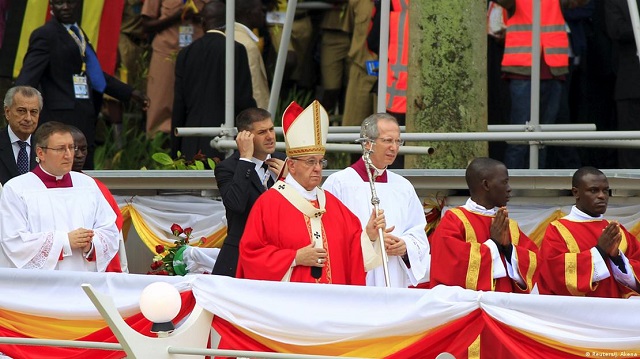
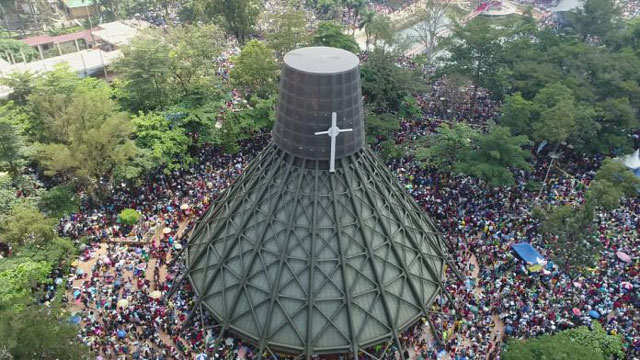
In his 1935 book Eddiini mu Uganda, Rev. Fr. J.L. Ddiba documented that the remains of Charles (Karoli) Lwanga were retrieved from the site of his death by Deni Kamyuka and Leon Lwanga, who had survived the purge.
The remains were carefully preserved by the missionaries in a metallic box and buried. However, there came a time when the box couldn’t be located until 1892 when it was unearthed.
Fr Ddiba notes that initially, Bishop Hirth assumed that all the remains belonged to Charles Lwanga. Yet, after consulting the diary of Fr Simeon Lourdel commonly known as Mapeera, it was revealed that there were remains of two individuals. Subsequently, they were examined, separated, and kept as relics.
The Uganda Martyrs were later officially proclaimed Saints by Pope Paul VI on Mission Sunday, October 18, 1964, at the close of the historic Second Vatican Council. This recognition came 78 years after their deaths and marked them as the first Black African Saints of the Roman Catholic Church.
The Uganda Martyrs were 45 young converts (including 22 Catholic and 23 Anglican) who were killed because of their faith between 1885 and 1887 mostly on orders of Kabaka Mwanga II of Buganda.
****
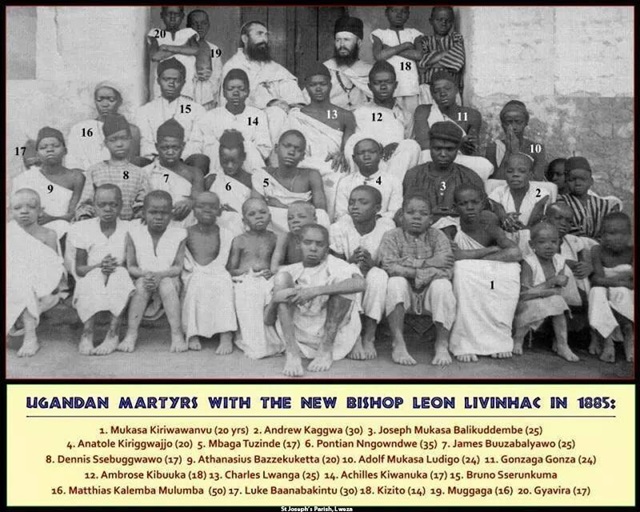
The 22 Catholic Martyrs
| # | Name | Date of death | Age at death | Patron saint of | Killed using |
| 1. | Achilleus Kewanuka | 3 June 1886 | 17 years | journalists, press writers, printers and artist. | Fire (burnt) |
| 2. | Adolphus Ludigo-Mukasa | 3 June 1886 | 24 years | farmers and herdsmen | Fire (burnt) |
| 3. | Ambrose Kibuuka Katekamu (Kateka Mulundaggana) | 3 June 1886 | 18 years | societies and youth movements such as scouts, YCW, Xaverians etc. | Fire (burnt) |
| 4. | Anatoli Kirigwajjo | 3 June 1886 | hunters and herdsmen | Fire (burnt) | |
| 5. | Andrew Kaggwa Kaahwa | 26 May 1886 | about 30 years | teachers, catechists and families | Panga and a knife |
| 6. | Athanasius Bazzekuketa Kizza | 27 May 1886 | 20 years | those in charge of finance, treasury and banks. | Spear |
| 7. | Bruno Sserunkuuma | 3 June 1886 | alcoholic, the violent, those with lust of flesh and improper marriage. | Fire (burnt) | |
| 8. | Charles Lwanga | 3 June 1886 | 25 years | African youth and Catholic action | Fire (burnt) |
| 9. | Denis Ssebuggwawo Wasswa | 25 May 1886 | 16 years | singers, musicians and choirs | |
| 10. | Gonzaga Gonza Nghonzabato | 27 May 1886 | 24 years | prisoners, travelers, ill-treated and those in trouble. | Spear |
| 11. | Gyavira Mayanja Musoke | 3 June 1886 | 17 years | traffic communications and those troubled by witchcrafts | Fire (burnt) |
| 12. | James Buuzabalyawo Kalumba Ssebayigga | 3 June 1886 | 26 years | merchants and co-operatives | Fire (burnt) |
| 13. | John Mary Kiwanuka Muzeeyi | 27 January 1887 | Panga | ||
| 14. | Joseph Mukasa Balikuddembe | 15 November 1885 [45] | 20 years | politicians and chiefs | Panga and fire |
| 15. | Kizito | 3 June 1886 | young children particularly those below the age of 15 | Fire (burnt) | |
| 16. | Luke (Lukka) Baanabakintu | 3 June 1886 | 30 years | fishermen, sailors, mechanics, students and black-smiths. | Fire (burnt) |
| 17. | Mathias Kalembe Mulumba Wante | 30 May 1886 | 50 years | Chiefs and Families | Knife and Pangas |
| 18. | Mbaaga Tuzinde | 3 June 1886 | 17 years | vocations mainly of the seminarians, aspirants, postulants and novices | Stick and Fire |
| 19. | Mugagga Lubowa | 3 June 1886 | 16 years | clubs, community development, culture and home craft | Fire (burnt) |
| 20. | Mukasa Kiriwawanvu | 3 June 1886 | hotels bars and restaurants | Fire (burnt) | |
| 21. | Noa Mawaggali | 31 May 1886 | the poor, technicians and the artists | Tied on the tree and dogs bit and then thrown on the road | |
| 22. | Ponsiano Ngondwe | 26 May 1886 | 30 years | soldiers, policemen and militia | Spear |
******
RELATED STORIES
✳>>>>>>>> HERE IS A FULL LIST OF UGANDAN MARTYRS (CLICK TO READ)1
✳>>>>>>> Last Ugandan Martyr Jean Marie Muzeeyi beheaded at Mengo in 1887 (CLICK TO READ)
 The Independent Uganda: You get the Truth we Pay the Price
The Independent Uganda: You get the Truth we Pay the Price



